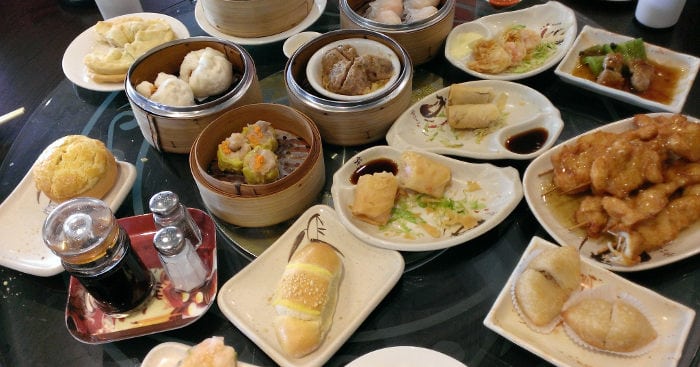
In this guide you’ll find descriptions of the most famous – and delicious – dishes in Chinese cuisine, with the name in English and Chinese (both in characters and in pinyin).
For those who are already 中国通 (zhōngguó tōng), experts on China, going to a restaurant and leaving satisfied isn’t a problem.
But who of us doesn’t remember our early experiences, menu in hand, in front of an insistent Chinese waiter who has decided not to let you look at the menu in peace, perhaps looking at a dictionary for some of the hundreds of characters in front of our eyes?
I still remember my first meal in China: traumatized by my arrival in this country where, despite three years of studying the language, nobody seemed to understand me, I decided to go to a familiar and international setting: McDonald’s.
The first stumbling block was in finding fast food since no one seems to know it by this name. To my great surprise, after interminable minutes of walking and a growling stomach, finally, it was there before me, like a mirage of an oasis in the desert, 麦当劳 (Maidanglao) the Chinese name for McDonald’s!
Not at all discouraged by the long trip by plane, the loneliness that started showing itself, and the difficulties in communicating, I decide to go in, confident to find a non-hostile environment. I take a few steps toward the counter, walking with my head up, despite feeling a myriad of dark eyes pointed toward me to examine the foreigner.
I finally arrive at my destination and I hear myself say “yi ge burger” in a bad mix between English and Chinese.
I quickly realize that my faith in my Chinese was badly placed, and by the questioning faces of the waiters trying to understand what I meant by my incomprehensible request, I can tell that they don’t have the slightest idea of what I want.
I try to explain myself, but it seems to only make the situation worse. Tired of my blabbering, they hand me an illustrated menu where I choose, with a certain frustration for my three years of useless Chinese, my sandwich!
One premise before beginning: in China there’s no separation between appetizers, first and second courses or dessert. All dishes are placed in the center of the table at the same time, where table mates take their own portions of food with chopsticks.
To conclude, if you’re afraid of not knowing the rules of Chinese etiquette, here you’ll find much useful information on how to behave during a meal in China.
Cold dishes
“Cold dishes”, or 凉菜 (liángcài) are served in much smaller portions, and brought to the table right away while waiting for the hot dishes to be ready. They are generally made up of raw vegetables or dried meats to be dipped in vinegar.
We might define them as appetizers, and among the most famous there are: 拍黄瓜 (pāi huángguā), or seasoned cucumbers, 凉拌拉皮 (liángbàn lā pí), or cold noodles, 老醋花生 (lǎo cù huāshēng) or nuts seasoned in vinegar, and 凉拌牛肉 (liángbàn niúròu), or beef served cold.
First courses
What we define as the first courses can be divided into noodles, soups, rice, and ravioli. Contrary to Western traditions, a small bowl of rice, or ravioli, can also be served at the end of the meal. Next, I’ll go on to describe the primary main courses with various choices of condiments.

Noodles
Pasta is a basic element of Chinese cuisine, so much so that there’s a dispute over who invented spaghetti – the Chinese or Italians? – it still seems to be unresolved and the source of great debate with taxi drivers during the ride between one part of the city and another.
The preparation of various types of Chinese noodles, sees the use of different types of ingredients. When speaking of 面 (miàn, in fact, it is referring to noodles prepared with grain flour. When talking about 粉 (fěn), this refers to noodles made with rice flour, which are lighter and more transparent. The ingredients for preparing them are generally water, flour, and salt.
How can you decide which noodles to order? The names you might see while flipping through the menu are many, so here’s a list of some of the categories of noodles that you’ll most frequently run across, essentially listed on the basis of the ingredients and type of cut.
拉面 (lāmiàn) – Grain flour noodles
The lamian are grain flour noodles made by hand (拉 means “to pull”, and refers to the gesture made with the hands and arms of the cook, while 面 means “noodles”). The most famous 拉面 are probably the 兰州拉面 (Lánzhōu lāmiàn, from the name of the city of Lanzhou, in Gansu province).
In some restaurants you can see them being prepared: the pasta is worked by the cook pulling it between one arm and the other, making it into spaghetti form to then energetically beat it on the work floor to give it greater elasticity.
猫耳朵 (māoěrduo) – Cat’s ears
The literal translation of 猫耳朵 is “cat’s ears” (猫 means “cat”, while 耳朵 in fact means “ears”). The name of this type of noodle is owed to its form, which calls to mind the ears of a cat.
This is a type of short noodle, very small and elongated. Don’t be scared when you see this name on the menu: it’s an innocent grain pasta that might remind you of earrings, and are mostly popular in the provinces of Shanxi and Shaanxi.
刀削面 (dāoxiāomiàn) – Noodles (cut by knife)
These noodles have their origins in Shanxi province and, as opposed to 拉面, 刀削面 are cut by knife(刀 means “knife”, 削 “to cut”, and 面 “noodles”). They’re a type of long grain pasta.
河粉 (héfěn) – Rice starch noodles
This type of pasta comes from Guangdong, in southern China. The name comes from traditions tied to the river 沙河 (shāhé, which crosses the region. The character 河 in fact means “river” while 粉 indicates, as was already mentioned, rice starch noodles. The 河粉 are large and flat.
米线 (mǐxiàn) – Gluten free rice noodles
The mixian (米 “rice” and 线 “line”), very fine gluten-free noodles from Yunnan, are an ancient dish of Chinese tradition.
米粉 (mǐfěn) – Rice starch noodles
Mifen (米 “rice”, 粉 “starch noodles”), are very fine rice noodles that come from southwest China, from the city of Guilin.
Just as the types of noodles that you can find in China are numerous, the same goes with the methods of preparation.
The first big subdivision to make when speaking of recipes is between those in soup and those that aren’t. Let’s start with noodles that aren’t in soup, which are divided into stir-fried noodles and cold noodles (often served as appetizers), passing on to those in broth.
炒面 (chǎo miàn) – Stir fried noodles
炒面, “stir-fried noodles” in a pot with oil, can usually be ordered in the following versions: 素炒面 (sùchǎomiàn), or stir-fried noodles with vegetables, 蛋炒面 (dànchǎomiàn), with eggs and 肉炒面 (ròuchǎomiàn), with meat.
凉面 (liáng miàn)- Cold noodles
“Cold noodles” are usually clear (due to the type of starchy flour that is used), and seasoned with soy sauce, spicy sauce, nuts and cucumbers cut into thin strips.
It is with this condiment that we can order 陕西凉皮 (shǎnxī liángpí), rice noodles from Shaanxi province. Something a little different are the 川味凉面 (chuān wèi liánɡ miàn), Sichuan cold noodles, which are made with grain flour, are spicy and usually seasoned with a peanut sauce.
面(miàn)- Noodles in soup
As far as noodles in soup go, they’re served in enormous overflowing bowls. Among the simplest are the 西红柿鸡蛋面 (xīhóngshì jīdàn miàn), cooked with eggs and tomatoes, and the 牛肉面 (niúròu miàn), with pieces of beef and pieces of minced coriander on top.
Rice
Just like grain, rice is a basic element of traditional Chinese cooking (simplified, you could say that grain is typical of the north of the country, while in the south rice is more widespread).
It is possible to order rice both as a side dish to the main courses, which would be the equivalent of our bread, and as a stand-alone dish, by ordering a 炒饭 (chǎofàn), “fried rice”.
If you want rice as a side dish, your selection will likely be a bowl of 米饭 (mǐfàn), or a combination dish.
米饭 (mǐfàn) – White rice
米饭 is simple boiled white rice, ordered as a side dish. It is usually served together with other dishes (or at the end of the meal, depending on the restaurant), and you can choose whether to order a small or large bowl. While all dishes are placed in the middle of the table and diners can take what they want, everyone has their own bowl of rice in front of them.
盖饭 (gài fàn) – Combination dishes with rice
If you like the idea of having your meal with rice on the side and want to have a quick meal during your lunch break, then 盖饭 is for you. 盖饭 is its own dish, combining white rice and a main entree (which could be meat, fish, vegetables, or tofu). When you order your dish you’ll have to choose from the list of main entrees, followed by the term 盖饭: in just a few minutes you’ll be served an enormous steaming plate.
Despite the majority of the Chinese ordering “fried rice” (炒饭) as a quick dish when they don’t have much time available (with everyone having their own portion in front of them), fried rice can also be ordered as a side dish.
There are many varieties of 炒饭. Among the most simple are 蛋炒饭 (dàn chǎofàn), fried rice with egg, 酱油炒饭 (jiàngyóu chǎofàn) cooked in soy sauce, or 老干妈炒饭 (lǎo gàn mā chǎofàn), fried in a tasty sauce of beef and black beans.
If you’d like to taste something vaguely familiar, you should probably choose a 扬州炒饭 (Yángzhōu chǎofàn).
扬州炒饭 (Yángzhōu chǎofàn) – Yangzhou fried rice
The name 扬州炒饭 comes from the city of the same name in the province of Jiangsu and refers to a variety of fried rice similar to the Cantonese rice served in every Chinese restaurant in Europe. The basic ingredients of this dish are egg, prosciutto, peas, carrots, and corn, all cooked in a skillet and then fired together with the rice. To these ingredients, you can add others, such as shrimp, onions, or other types of vegetables.
Ravioli
Who doesn’t love 饺子 (jiǎozi)? Despite their homeland being Dongbei, they are widespread throughout the country. Eaten by both the Chinese and strangers, Chinese ravioli are a must-try if you’re in China. But if you’re expecting to find the same Chinese ravioli you’re used to ordering in Chinese restaurants in Italy, forget it. Real Chinese ravioli are smaller, tastier, and lighter. In a word: better.
Eaten on all occasions, they can’t be missing on the day of Chinese New Year, when the family gets together around the table to make them in industrial-size quantities.
When you go to a restaurant and order 饺子, you’ll be advised to dip them in a mix of vinegar, soy, and spicy sauce: get over your first instinct to refuse after having seen the containers they come in and try it!
饺子 is the common name for referring to Chinese ravioli, for which there are varying types.
In the majority of cases, they are boiled in hot water, but you can also find other varieties, such as those fried in a skillet.
水饺 (shuǐjiǎo) – Boiled ravioli
From the first character of the term 水 (“water”), it’s easy to figure out that these are ravioli cooked in boiling water. You can also eat them in soup, without draining the water they’re cooked in, to which are added a few ingredients to make the broth tastier.
蒸饺 (zhēngjiǎo) – Steamed ravioli
The variety of steamed ravioli is called 蒸饺, from the term 蒸, “steam”.
锅贴 (guōtiē) or 煎饺 (jiānjiǎo) – Fried ravioli
Most commonly called 煎饺, these ravioli are cooked on a skillet: they have an unmistakable flavor, but are certainly not lighter than the other two mentioned above.
Chinese ravioli are so famous and delicious that there are restaurants that specialize in its preparation. Here it’s possible to find all types of flavors (and colors!), there’s only the challenge of choosing.
Among the most common fillings you could choose from, you can pick between:
Vegetable filling
The most popular vegetarian ravioli are the 菠菜鸡蛋饺子 (bōcài jīdàn jiǎozi), prepared with spinach and egg. Alternately there are 白菜饺子 (báicài jiǎozi), ravioli filled with clear cabbage. The Chinese love them so much that they’ve even made a dessert version, which would be the 红豆泥饺子 (hóngdòu ní jiǎozi), ravioli filled with red strawberry cream.
Meat filled
Meat filled ravioli are generally filled with pork, like 猪肉韭菜饺子 (zhūròu jiǔcài xiàn jiǎozi), filled with pork and chives, but there are also variants with beef or mutton. 牛肉胡萝卜饺子 (niúròu húluóbo jiǎozi) are for example filled with beef and carrots, while 羊肉葫芦饺子 (yángròu húlu xiàn jiǎozi) are full of mutton and squash.
Fish filled
In 三鲜饺子 (sān xiān jiǎozi, besides fish you’ll also find meat: this particular type is in fact filled with a concoction of meat (pork), fish (little shrimp), vegetables (chives), and egg. If you prefer only a fish filling, then order the 虾仁饺子 (xiārén jiǎozi), full of shrimp.
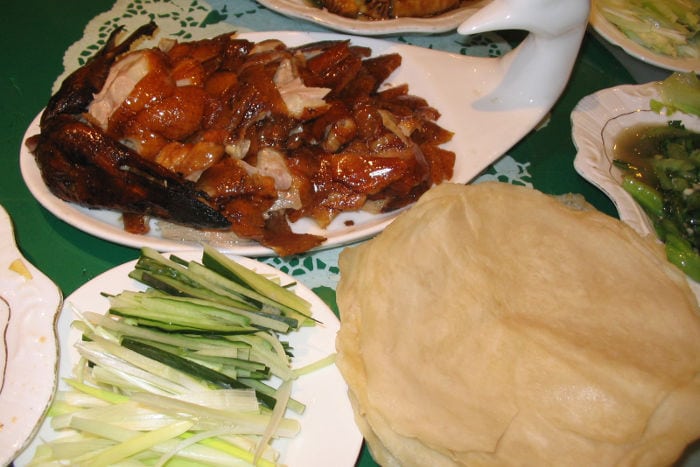
Meat and fish dishes
Finding a good steak or mix of fried fish is a hard undertaking in China, but in exchange, you can find interesting little dishes of tasty meat cut into pieces or entire spiced fish.
Usually, Muslim restaurants have a good choice of mutton or beef. Fish are not generally cleaned of their skin and bones, which are still rather easy to eliminate. Meat or fish dishes can be accompanied by a bowl of white rice.
If you’re eating alone, or at informal meals where everyone wants their own dish, you can opt for 盖饭. Here are some of the principal meat and fish dishes.
Meat
Without asking too many questions about where the meat comes from, go into a restaurant and try one of the delicacies listed below, you won’t regret it! The Chinese vary widely in their consumption of meat, eating pork, beef, mutton, donkey, chicken, duck and… much more.
If you’re asking if it’s true that they eat dogs in China, the answer is yes, but it isn’t particularly common (here you’ll find more details on that subject). In some restaurants, you can also find it on the menu.
If your itinerary in China includes a stop in Beijing, remember to pass by 王府井 (Wángfǔjǐng): turning into a hidden street halfway along the shopping street, you’ll find a tiny market of local “delicacies” and more.
Besides tasty dishes and steaming drinks, you could also decide to buy a skewer of roaches, stuck onto the skewer while still moving their legs, and then fried; maggots, scorpions or other bizarre foods. It’s an experience to try at least once in your life… for those who have the stomach!
If you’re not big on maggots, then here’s a list of more common meats for we Westerners.
烤鸭 (kǎoyā) – Peking duck
If you’re in Beijing, you can’t leave the city without trying 烤鸭 (烤 means “roasted” while means 鸭 “duck”) 烤鸭, also known as “Peking duck”, the typical dish of the capital.
The duck in question is first treated, then roasted. Once cooked it is cut into small pieces and served to guests. First, the skin will be brought to the table, soft and crunchy, followed by the meat, accompanied by pancakes (round and very thin), celery and onions chopped into fine strips, and lastly a little sauce of sweet beans.
To taste this dish you should fill a pancake with all the ingredients.
京酱肉丝 (jīng jiàng ròu sī) – Strips of pork in Pekinese sauce
Another especially famous dish in Beijing is 京酱肉丝. You may vaguely be reminded of 烤鸭 by the way you eat it, but it has a totally different flavor.
京酱肉丝 is prepared with pork cut into strips and fried in bean sauce that gives it a sweet and sour flavor.
The meat is generally served on a bed of chopped onions sliced very finely at the center of the dish while on the side there are squares of tofu or round pancakes. As with 烤鸭, you make a wrap of meat and onions and bring it to your mouth.
宫保鸡丁 (gōng bǎo jī dīng) – Kung Pao chicken nuggets
A variant of what we know as chicken and almonds, so famous in Chinese restaurants of the West, could be 宫保鸡丁, a dish from the Sichuan region (here you’ll find an article dedicated to Sichuan dishes).
This dish is prepared with nuggets of chicken, onion, dried chili peppers, garlic, soy sauce, vinegar, ginger, and above all, little nuts. The flavor is salty and spicy, perfect for Western tastes and loved by foreigners.
鱼香肉丝 (yú xiāng ròu sī) – Strips of pork with fish scent
Despite a name that will undoubtedly fool you (鱼 “fish”, 香 “scent”, 肉 “meat” and 丝 “wire”), this dish has nothing to do with fish. The Sichuan sauce鱼香, commonly used in making other dishes (see 鱼香茄子), is prepared with the use of the following ingredients: soy sauce, vinegar, salt, sugar, chili peppers, spicy bean sauce, and onion.
The meat is first cooked in a skillet, then stir-fried along with the sauce 鱼香, carrots, soy sprouts, and mushrooms.
回锅肉 (huíguōròu)- Twice cooked pork
The name of this dish, also originally from Sichuan, literally means “meat returned to the skillet” (回 “return”, 锅 ”skillet”, 肉 “meat”), and means that the pork bacon is first boiled in spicy water then stir-fried in a skillet.
This spicy meat dish is served on a plate along with leeks, white cabbage, chili peppers, onions, and garlic in which it was cooked. The taste is increased with soy sauce, spicy bean sauce, pepper, and ginger.

Fish
水煮鱼 (shuǐ zhǔ yú) – Boiled fish
This is a Sichuan recipe of soft white fish prepared in a swill of water, oil, green pepper, and often dried chili pepper (水 “water”, 煮 “boiled”, 鱼 “fish”).
糖醋鲜鱼 (táng cù xiān yú) – Sweet and sour fish
糖醋鲜鱼 (糖 “sugar”, 醋 “vinegar”, 鲜 “fresh” 鱼 “fish”) is a fish in sweet and sour sauce, whose preparation requires the seasoning of a sweet and sour sauce made of carrots, peppers, tomatoes, garlic, vinegar, sugar, soy sauce and ostrich oil.
重庆烤鱼 (Chóngqìng kǎo yú) – Chongqing grilled fish
A traditional dish of Chongqing, in south-central China, is 重庆烤鱼 (重庆 “Chongqing”, 烤 “roasted”, 鱼 “fish”): spicy roasted fish, served with vegetables.
虾仁炒蛋 (xiārén chǎo dàn) – Scrambled eggs and shrimp
This is a very simple recipe that has scrambled eggs together with onion, then stir-fried together with previously cooked shrimp.
蒜蓉粉丝蒸扇贝 (suàn róng fěnsī zhēng shànbèi) – Steamed scallops with oil and noodles
This is a simple dish from Guangdong, but very tasty for those who love the taste of scallops, prepared together with 粉丝 (fěnsī), clear, thin, very fine noodles, and garlic seasoned in soy sauce.
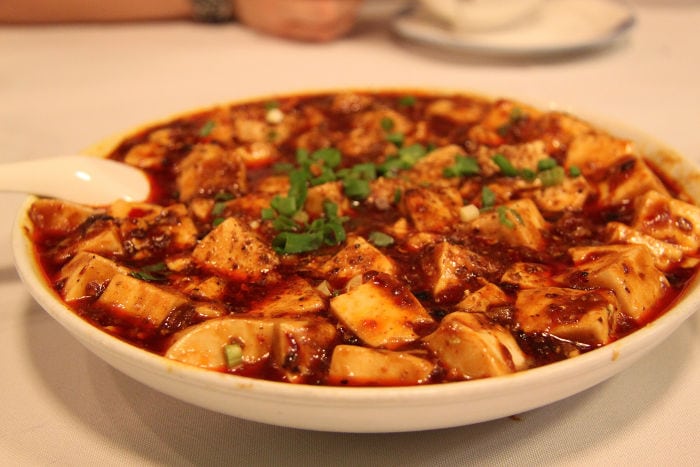
Vegetable and tofu dishes
Being a vegetarian in China is extremely difficult because, despite the wide variety of tofu dishes (soybean curd) or greens, the ingredients added during cooking are often unknown.
It’s not unusual that even in seemingly vegetarian vegetable dishes chicken essence or animal fats are added during preparation, and are therefore not visible.
If you say that you can’t eat meat and ask if there are any animal fats in the dishes, you won’t necessarily be told the truth, according to the principle of what the eye doesn’t see, the heart won’t regret it.
If you’d like some advice: if you’re a vegetarian, it’s best that you prepare your food yourself, or go to vegetarian or vegan restaurants, where you can be certain of where the products come from. Below are some vegetable or tofu dishes in detail.
Vegetables
地三鲜 (dì sān xiān) – The three freshness of the earth
This bizarre name (地 “earth”, 三 “three”, 鲜 “fresh”), essentially means a dish of potatoes, eggplant, and fried green peppers stir-fried together with soy sauce and garlic, that comes from Dongbei.
酸辣土豆丝 (suān là tǔdòu sī) – Stir fried spicy potato strips
Another dish from Sichuan 土豆丝 is a spicy sweet and sour dish of potatoes cut into very thin strips and seasoned with garlic, onions, and vinegar.
鱼香茄子 (yú xiāng qiézi) – Eggplants in fish scent
As you’ve certainly come to understand, the cuisine of Sichuan is extremely rich. We’ve already spoken about the sauce 鱼香, previously mentioning 鱼香肉丝: the ingredients are the same. Often pork is added to the eggplant, so if you don’t want it let that be known when ordering.
干煸豆角 (gān biān dòujiǎo) – Stir fried beans
干煸豆角 is a typical dish of Sichuan, of green beans made spicy by the massive presence of dried red chili peppers. They’re stir-fried in a skillet with garlic, onion, soy sauce, and a little oil (from here it gets its name 干煸豆角: 干 “dry”, 煸 ”mix”, and 豆角 “beans”). They are almost always cooked together with pork.
Tofu
One of the foods foreigners miss the most in China is without a doubt cheese. A variant of cheese, which only very, very, vaguely resembles it, is tofu: soybean curd.
The taste of tofu is much more delicate than that of cheese, and for this, it is often seasoned in spices or used as a side dish.
If you’re curious to try a tofu-based dish, here are a few special ones (you’ll find a description of “stinky tofu” in street food).
麻婆豆腐 (má pó dòufu) – Mapo Tofu
A most famous dish of Sichuan tradition is without a doubt 麻婆豆腐. Very soft cubes of tofu that melt upon contact with the tongue, are served in a very spicy sauce and full of dried red chili peppers and pepper that will set your palate on fire.
The sauce is prepared with, besides the spicy ingredients already mentioned, bean paste, fermented soybean sauce, soy sauce, garlic, and coriander.
Hot pot
火锅 (huǒguō), a pot of boiling water placed on the table where you’re eating, where you cook your food yourself (火 means “fire”, 锅 “pot”), deserves a section of its own.
Tradition attributes the hot pot to Mongol culture. This recipe then spread throughout all of China, taking on different forms from region to region.
Very famous is Chongqing 火锅, where to the broth is obviously added Sichuan pepper and chilies.
When you order 火锅, whether from Chongqing or not, you can choose the level of spice of the broth in which you cook your own meal, and is divided into 微辣 (wēi là) lightly spicy, 中辣 (zhōng là) medium spice, and 特辣 (tèlà), especially spicy. 特辣 is recommended only for those with a strong stomach! If you don’t like spice, you can always ask for a not spicy hot pot 不辣 (bù là).
Once you choose, take your menu and choose the ingredients to order which will then be cooked in your big pot. There’s something for all tastes: from meats (in thin slices) to fish, from greens to tofu, and even noodles.
When the waiter brings your trays to the table, all you’ll have to do is pick your goodies from the plate with chopsticks and dip them in the boiling broth. Once cooked, you’ll have to go fish them out (probably together with those of your table mates), and you can eat them plain, or dip them in one of the available sauces.
In hot pot restaurants, you can find an infinity of sauces to mix according to your personal tastes. Usually, the base for creating your own sauce (火锅酱 – huǒguōjiàng) is sesame sauce (芝麻酱 – zhīmajiàng), or peanut sauce (花生酱 – huāshēngjiàng) of which, to keep it classic, you can add soy, vinegar, crushed nuts, coriander, or give in to your fantasy.
A curiosity: in the big hot pot chains you can have a manicure while you wait, with so much nail polish, or will be offered appetizers or fruit juice.
This is the case with the famous chain 海底捞 (Hǎidǐ Lāo), a recommended choice for those looking to try a good hot pot!
Sweets
Desserts are usually brought to the table along with other dishes. If you go to what I like to call little dives, you won’t be able to find any type of sweets. Here’s what you might want to try (other sweets are described in holiday specialties)!
蛋挞 (dàntà) – Egg tarts
Very popular in Hong Kong and Macao, the 蛋挞 seem as if they were “imported”. This round sweet is made by baking a layer of pasta filled with egg cream. The result is fantastic and can be eaten both hot and cold.
Drinks
Don’t be surprised if as soon as you sit down in a restaurant your glass will be filled with hot water or water that noodles were cooked in, it’s edible!
Contrary to our habits, the Chinese consider it to be important to drink hot liquids during meals. They’ve even managed to invent hot Coca-Cola, boiling it together with ginger! And the result is… not too bad, something to try!
But if water, tea, or hot Coca-Cola aren’t your thing, you can always go for the traditional drinks. In China you can find 可口可乐 (kěkǒukělè – “Coca-cola”), 芬达 (fēndá – “Fanta”), 雪碧 (xuěbì – “Sprite”), or local drinks like 酸梅汤 (suānméitāng – “prune juice”), 花生奶(huāshēngnǎ – “peanut milk”)or even 奶茶 (nǎichá – “milk tea”).
In China, there’s also a discreet selection of Chinese beers, all light enough in strength, and generally served in 750 ml bottles. The most famous is 青岛 (qīngdǎo píjiǔ – “Qingdao Beer”), whose factory is found in the city of the same name.
One of the first Chinese words that you’ll certainly want to learn if you love beer is 冰 (bīng), to ask for a cold beer, and not the room temperature in which it is usually served.
Are you ready to order? Buon appetito!
Photo Credits: ![]() Tasty Noodle Dim Sum by Mack Male
Tasty Noodle Dim Sum by Mack Male
![]() 北京烤鸭 by Wearn
北京烤鸭 by Wearn
![]() Fish stew at Dainty Sichuan Food in South Yarra by Katherine Lim
Fish stew at Dainty Sichuan Food in South Yarra by Katherine Lim
![]() Mapo tofu by Matt Ryall
Mapo tofu by Matt Ryall
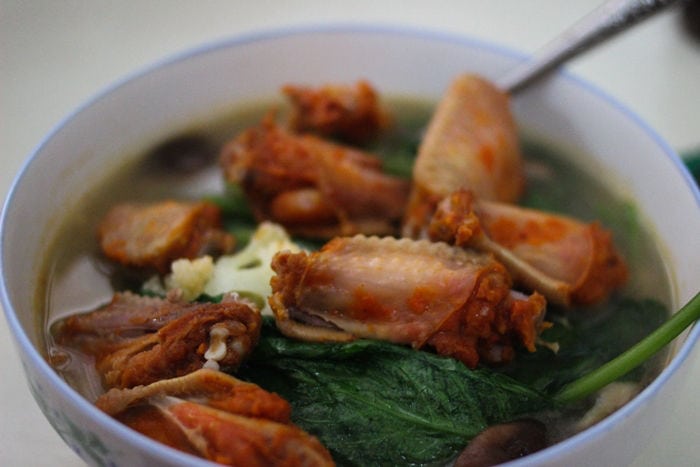
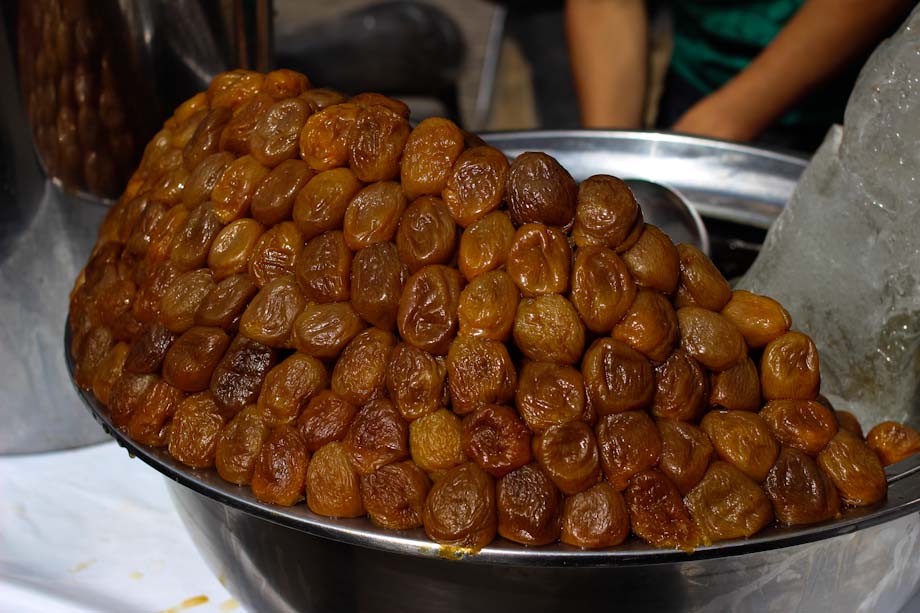
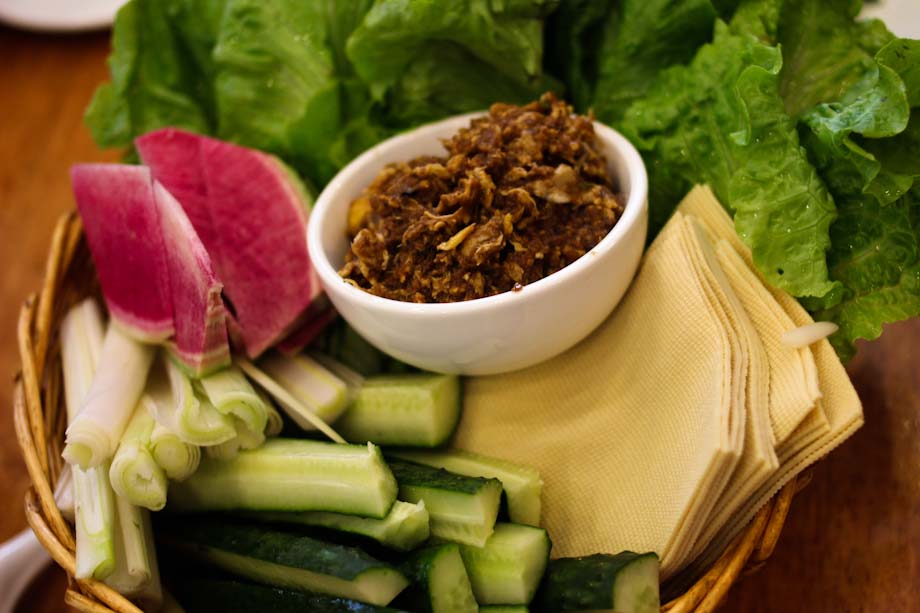

Oh, man. The food in that first picture looks amazing. Hm… Man, now I want to go out for some Chinese food. I’d love to find something tasty!
: )
This is a great guide! Thanks for putting it together. I have found ordering food in China to be very difficult on some occasions, especially when there are no pictures on the menu to point to. Placing an order in a restaurant in China can be intimidating, but I have never starved, there is so much great food throughout the country! This will definitely help me the next time I’m there.
Hello Que,
thank you for your comment!
We are happy the guide was useful to you!